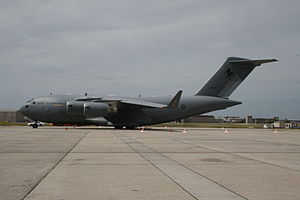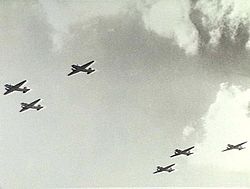- No. 86 Wing RAAF
-
No. 86 Wing RAAF
RAAF C-17 GlobemasterActive 1945–1964, 1987–current Country Australia Branch Royal Australian Air Force Role Tactical and strategic air lift Part of Air Lift Group Headquarters RAAF Base Richmond Motto Precision Commanders Notable
commandersAngus Houston (1994–95) No. 86 Wing RAAFComponents No. 86 Wing is a Royal Australian Air Force transport wing. Coming under the aegis of Air Lift Group, it is headquartered at RAAF Base Richmond, New South Wales. The wing comprises No. 36 Squadron, operating Boeing C-17 Globemasters, and No. 38 Squadron, flying Beechcraft Super King Airs. Formed in the last year of World War II to conduct ground attack operations against the Japanese, No. 86 Wing was reorganised in 1946 as a transport formation flying C-47 Dakotas. It was first based at RAAF Richmond in 1949, and began operating C-130 Hercules in 1958. Disbanded in 1964, the wing was re-established at Richmond in 1987, flying Boeing 707s as well as Hercules. The Hercules were transferred to No. 84 Wing in 2006, concurrent with the introduction of the Globemaster.
History
Established as an attack formation in March 1945, No. 86 Wing originally comprised No. 1 Squadron (flying de Havilland Mosquitos) and No. 93 Squadron (Bristol Beaufighters). It was initially based on the island of Morotai in the South West Pacific theatre, as part of the Australian First Tactical Air Force.[1] Delays in making the aircraft operational at their forward base on Labuan meant that the wing only completed three combat missions before the end of the Pacific War, conducting rocket and machine-gun attacks on targets in Sarawak.[2]
No. 86 Wing was re-formed as a transport unit at RAAF Station Schofields, New South Wales, in August 1946, and was assigned control of Nos. 36, 37, and 38 Squadrons, flying C-47 Dakotas. No. 37 Squadron disbanded in 1948. That year, crews from Nos. 36 and 38 Squadrons departed for Europe to take part in the Berlin Airlift, which lasted until the following year. The Australians were responsible for delivering over 16 million tons of supplies, and almost 8,000 passengers. On 22 June 1949, No. 86 Wing and its two remaining squadrons transferred to RAAF Station Richmond.[3] Following the return of crews from Berlin, the wing was able to release Dakotas of No. 38 Squadron to participate in the Malayan Emergency starting in 1950.[4]
In 1954, No. 86 Wing relocated to Canberra, but returned to Richmond four years later. Having earlier augmented its complement of Dakotas with Convair 440 Metropolitains, in 1958-59 the wing began operating Hercules transports, when No. 36 Squadron took delivery of twelve C-130As. They remained in service for twenty years, amassing 147,000 accident-free flying hours.[5] No. 38 Squadron received the RAAF's first DHC-4 Caribou tactical transports in April 1964, replacing its venerable Dakotas. The six Caribous initially delivered were despatched to South East Asia for service in the Vietnam War that August. The same month, No. 86 Wing was disbanded.[6][7] It reformed at Richmond on 2 February 1987, under the newly established Air Lift Group, and consisted of No. 33 Squadron, operating Boeing 707s, and Nos. 36 and 37 Squadrons, flying C-130 Hercules. No. 486 Maintenance Squadron and Air Movements Training and Development Unit (AMTDU) were also under its control. No. 34 Squadron, the RAAF's VIP transport unit based at RAAF Base Fairbairn, and No. 32 Squadron, flying HS-748 air navigation trainers at RAAF Base East Sale, became part of No. 86 Wing in June 1988 and July 1989, respectively.[8]
As well as participating in military exercises and overseas peacekeeping commitments, the Hercules, Caribous and 707s of No. 86 Wing became synonymous with disaster relief and emergency transport in Australia and the region.[9][10] During 1994-95, the wing was commanded by Group Captain (later Air Chief Marshal) Angus Houston, who in 2005 was appointed Chief of the Defence Force, only the third RAAF officer to be raised to the most senior position in the Australian armed services.[11] By the early 2000s, Nos. 32, 33, and 34 Squadrons had been transferred to No. 84 Wing, and AMTDU to No. 85 Wing.[12] RAAF C-130 operations were concentrated in No. 37 Squadron in November 2006, when No. 36 Squadron transferred its C-130Hs prior to re-equipping with the Boeing C-17 Globemaster III and relocating to RAAF Base Amberley, Queensland.[13] The RAAF's DHC-4 Caribous, operated by No. 38 Squadron out of RAAF Base Townsville, were retired at the end of 2009, to be replaced by Super King Airs built by Hawker Pacific.[14] No. 37 Squadron was transferred to No. 84 Wing on 1 October 2010.[15]
Notes
- ^ Odgers, Air War Against Japan, pp.443-444
- ^ Odgers, Air War Against Japan, pp.474-475
- ^ Roylance, Air Base Richmond, pp.92-93
- ^ Odgers, Diggers, pp.334-335
- ^ Roylance, Air Base Richmond, pp.97-98
- ^ Roylance, Air Base Richmond, pp.102,114
- ^ Stephens, The Royal Australian Air Force, pp.159-160
- ^ Roylance, Air Base Richmond, pp.107-108,116-117
- ^ Roylance, Air Base Richmond, pp.110-111
- ^ Stephens, The Royal Australian Air Force, pp.310-311
- ^ "Chief of the Defence Force". Department of Defence. 2010. http://www.defence.gov.au/cdf/index.htm. Retrieved 30 November 2010.
- ^ "RAAF Base Richmond Reinvestment Project". Department of Defence. August 2003. http://www.aph.gov.au/house/committee/pwc/richmond/submissions/sub1.pdf. Retrieved 30 November 2010.
- ^ "Royal Australian Air Force Squadrons Celebrate New Role". Department of Defence. 17 November 2006. http://www.defence.gov.au/media/DepartmentalTpl.cfm?CurrentId=6145. Retrieved 30 November 2010.
- ^ "Caribou Flies Into History". Australian Aviation. 27 November 2009. http://dev-wp.australianaviation.com.au/caribou-flies-into-history/. Retrieved 30 November 2010.
- ^ "Restructure of Air Lift Group Units". Department of Defence. 5 October 2010. http://www.defence.gov.au/media/download/2010/Oct/20101005c/index.htm. Retrieved 30 November 2010.
References
- Odgers, George (1968) [1957]. Australia in the War of 1939-1945: Series Three (Air) Volume II – Air War Against Japan, 1943-1945. Canberra: Australian War Memorial. http://www.awm.gov.au/histories/second_world_war/volume.asp?levelID=67913.
- Odgers, George (1994). Diggers: The Australian Army, Navy and Air Force in Eleven Wars. Sydney: Lansdowne. ISBN 1863023852. http://www.awm.gov.au/histories/second_world_war/volume.asp?levelID=67913.
- Roylance, Derek (1991). Air Base Richmond. RAAF Base Richmond: Royal Australian Air Force. ISBN 0646052128.
- Stephens, Alan (2006) [2001]. The Royal Australian Air Force: A History. London: Oxford University Press. ISBN 0195555414.
Categories:- RAAF wings
- Military units and formations established in 1945
Wikimedia Foundation. 2010.



